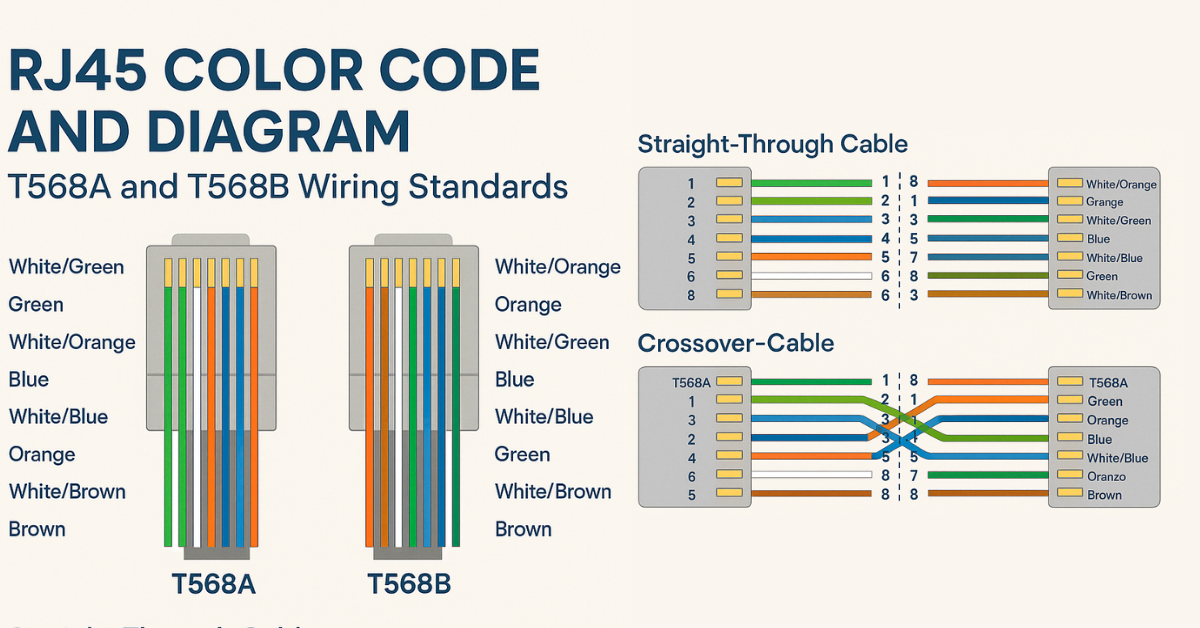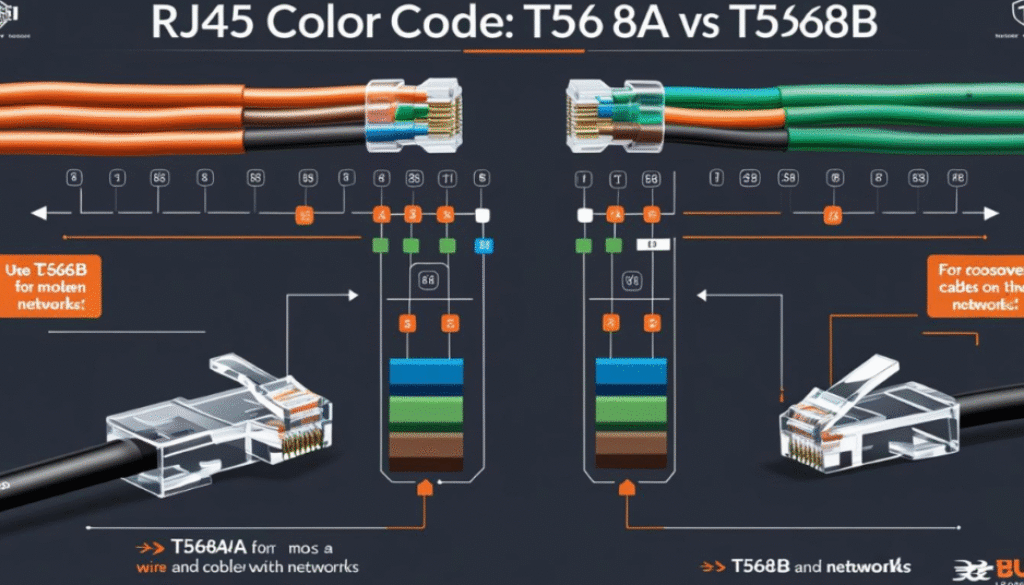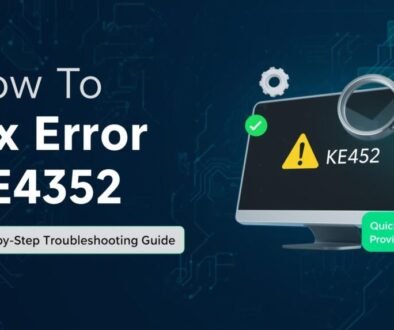RJ45 Color Code and Diagram: A Complete Guide for Network Cabling
When it comes to Ethernet networking, understanding the RJ45 color code and diagram is essential. Whether you’re setting up a small home network or managing large-scale data centers, knowing how to correctly wire Ethernet cables ensures stable and efficient data transmission.
In this comprehensive guide, we’ll cover what an RJ45 connector is, the difference between T568A and T568B wiring standards, and how to use color-coded diagrams to create Ethernet cables with confidence.
What is an RJ45 Connector?
An RJ45 (Registered Jack 45) is an 8-pin connector commonly used for Ethernet networking. These connectors are typically found on the ends of Cat5e, Cat6, and Cat6a cables and plug into Ethernet ports on computers, switches, routers, and patch panels.
RJ45 connectors are essential for twisted pair cabling used in structured network wiring. Their proper installation using the correct wiring standard ensures consistent and reliable network performance.
Why RJ45 Color Code Matters
The color code in an RJ45 connector helps technicians correctly match and arrange the 8 wires inside a twisted-pair Ethernet cable. Following a standard wiring scheme prevents crosstalk, maintains signal integrity, and ensures compatibility with various network devices.
Incorrect wiring can result in:
- Network failures
- Poor signal quality
- Incompatibility between devices
Thus, knowing the right RJ45 color code and diagram is key to network success.

T568A vs. T568B Wiring Standards
There are two main color coding standards for RJ45 connectors:
T568A Standard
This is often used in residential installations and is the default standard for federal government contracts in the U.S.
T568A color code:
- White/Green
- Green
- White/Orange
- Blue
- White/Blue
- Orange
- White/Brown
- Brown
T568B Standard
This is the more commonly used standard in commercial networks and data centers.
T568B color code:
- White/Orange
- Orange
- White/Green
- Blue
- White/Blue
- Green
- White/Brown
- Brown
Pro Tip: Choose T568B for consistency in business and mixed network environments unless your equipment or contract specifies T568A.
RJ45 Pinout Diagram
Straight-Through Cable (Both Ends Same Standard)
Used for connecting different devices like:
- Computer to Switch
- Router to Modem
If you use T568B on both ends, your cable will be a straight-through cable.
Crossover Cable (T568A on One End, T568B on the Other)
Used to connect similar devices:
- Switch to Switch
- Computer to Computer
How to Crimp an RJ45 Connector – Step-by-Step Guide
Follow these steps to make your own Ethernet cable:
Tools Needed:
- RJ45 Crimping tool
- Ethernet cable (Cat5e, Cat6, etc.)
- RJ45 connectors
- Wire stripper
- Cable tester (optional but recommended)
Instructions:
- Strip the Cable Jacket
Remove about 1 inch (2.5 cm) of the outer insulation to expose the twisted pairs. - Untwist the Wires
Carefully untwist the pairs and straighten the wires. - Arrange the Wires by Color Code
Choose T568A or T568B and align the wires accordingly. - Trim the Wires Evenly
Use scissors or a cable cutter to ensure the wires are the same length. - Insert Wires into RJ45 Connector
Make sure each wire goes into its respective slot in the connector. - Crimp the Connector
Insert the connector into the crimping tool and press firmly. - Test the Cable
Use a cable tester to verify the cable is wired correctly and functional.
Common Mistakes to Avoid
- Mixing T568A and T568B unintentionally (unless making a crossover cable)
- Not fully inserting wires into the connector before crimping
- Leaving too much exposed copper, which can lead to interference
- Skipping the cable tester step—always verify the final result
Which RJ45 Wiring Standard Should You Use?
Both T568A and T568B function the same in most applications. However:
- Use T568A if you’re matching existing residential wiring.
- Use T568B in business networks, especially if you’re replacing or extending existing infrastructure.
Consistency is more important than which standard you choose. Stick with one standard across your network for compatibility and easier troubleshooting.
RJ45 Color Code for Different Cable Categories
Cat5e and Cat6 Cables
Both use the same RJ45 pinout standards (T568A or T568B), although Cat6 cables have a plastic separator and thicker insulation for higher bandwidth and reduced interference.
Shielded vs. Unshielded Twisted Pair (STP vs. UTP)
STP cables are used in high-interference environments (e.g., industrial settings), while UTP cables are sufficient for most home and office networks. The RJ45 wiring color code remains the same regardless.
Summary: RJ45 Color Code and Diagram
| Pin | T568A Color | T568B Color |
| 1 | White/Green | White/Orange |
| 2 | Green | Orange |
| 3 | White/Orange | White/Green |
| 4 | Blue | Blue |
| 5 | White/Blue | White/Blue |
| 6 | Orange | Green |
| 7 | White/Brown | White/Brown |
| 8 | Brown | Brown |
Understanding and applying the correct RJ45 color code and diagram is essential for reliable Ethernet cable installation. Whether you’re working on a new setup or troubleshooting an existing connection, following T568A or T568B standards will ensure your network performs optimally.
Frequently Asked Questions (FAQs)
1. Can I mix T568A and T568B in a network?
It’s not recommended unless you’re intentionally making a crossover cable. Stick to one standard for all connections to avoid confusion and connection issues.
2. Is there a performance difference between T568A and T568B?
No. Both wiring schemes offer the same performance. The choice is mainly about compatibility and consistency.
3. What happens if the RJ45 is wired incorrectly?
Incorrect wiring can cause:
- Network disconnections
- Reduced speed
- Hardware incompatibility
- Failure to detect the cable
4. Are crossover cables still needed?
Modern devices support Auto MDI-X, which automatically adjusts for straight or crossover cables, but it’s still helpful to know how to make them.
5. Do I need special RJ45 connectors for Cat6 cables?
Yes. Cat6 connectors are designed to accommodate thicker wires and shielding. Use the right type for optimal performance.
Final Thoughts
Understanding the RJ45 color code and diagram is crucial for anyone working with Ethernet networking. Whether you choose T568A or T568B, consistent and correct wiring will save you time, reduce troubleshooting, and keep your network running smoothly.
For professionals, DIYers, or IT technicians, mastering this fundamental skill ensures you’re well-prepared for any cabling task.



